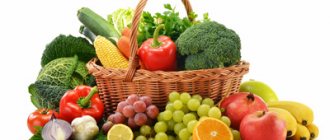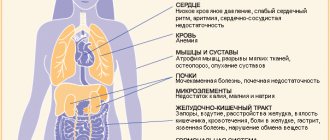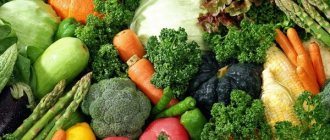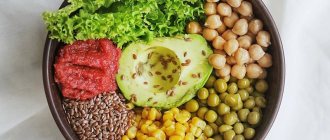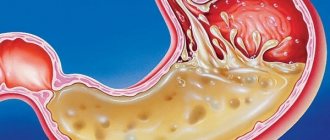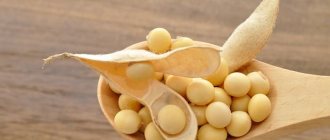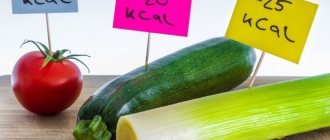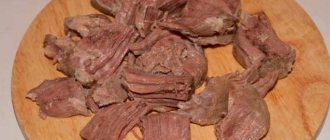How much iodine does a person need per day?
As we have already noted, a healthy person needs 100-200 mcg of iodine per day. However, this figure may change under the influence of a number of factors:
| A group of people | Daily iodine requirement, mcg |
| infants up to 12 months | 90-120 |
| preschool children | 120 |
| children 7-9 years old | 140-150 |
| children 10-12 years old | 180-200 |
| teenagers and adults up to 35 years old | 200 |
| adults over 36 years old | 180 |
| pregnant women | +30 mcg to normal for age |
| nursing women | +60 mcg to normal for age |
The human body is not able to synthesize iodine. We get it from food, water and air. Residents of Mediterranean countries practically never have a shortage of this microelement, since their diet is rich in fish and seafood. In addition, the coastal air itself contains a significant amount of iodine.
It is more difficult for residents of all other regions: according to statistics, almost two billion people on our planet have some degree of iodine deficiency. To cope with this problem, it is important to saturate your diet with seafood and fish. They allow the body to most effectively replenish iodine deficiency. As for vitamin complexes and food supplements with this microelement, they should be taken only as prescribed by your doctor.
Persimmon
There is quite a lot of iodine in persimmon, although not as much as in seaweed. But many more people like persimmon. In addition to beneficial iodine, it contains magnesium, sodium, iron (in terms of their content it surpasses even apples, the well-known healthiest fruit), as well as vitamins A, C and P.
Persimmon mousse
3 persimmons 1 glass of sugar ½ packet of gelatin 2 tbsp. lemon juice 1.5 cups water
Article on the topic
Salads, side dishes, casseroles and pies. What to cook from persimmons Step 1. Wash the persimmons, cut into quarters, remove the seeds. Step 2. Fill with water, add lemon juice. Leave for half an hour. Step 3. Boil in the same water for 15 minutes. While it is boiling, soak the gelatin in ½ cup of cold water. Step 4. Rub the boiled persimmon through a sieve. Pour the strained broth into it, add sugar and add gelatin. Mix. Step 5. Cool the finished mass to a temperature warmer than room temperature, then beat until thick foam. Step 6. Pour into molds and place in the refrigerator to set.
Products containing iodine
Here are the main iodine-containing foods that must be present in your diet:
| Product name | Iodine content, mcg |
| sea fish | 400 |
| dried porcini mushrooms | 350 |
| seaweed | 300 |
| squid | 300 |
| River fish | 200-300 |
| feijoa | 80-300 |
| shrimps | 190 |
| hake | 160 |
| pollock | 150 |
| cocoa | 117 |
| mackerel | 100 |
| blueberry | 70 |
| herring | 60 |
| oysters | 60 |
| tuna | 50 |
| flounder | 50 |
| spinach | 20 |
| chicken eggs | 12 |
| beef | 12 |
| bread | 9 |
| Black tea | 8 |
| radish | 8 |
| potato | 3,5 |
What affects iodine absorption
Salting food with iodized salt or creating a menu exclusively from iodine-containing products is not enough. All efforts will come to nothing if iodine is not absorbed. This can happen for several reasons:
Micronutrient deficiency
- : namely selenium, copper, cobalt, zinc.
Consumption of foods that reduce iodine absorption
- : mustard, turnips, soybeans, sunflower seeds, dill. This does not mean that these products should be abandoned forever. Each of them contains its own portion of benefits. You just need to take care to replenish your iodine reserves after eating them.
Poor quality water
- . The presence of chlorine and fluorine in water blocks the absorption of iodine. So does the presence of mercury and lead.
Taking medications
- . Penicillin, aspirin, steroid hormones, erythromycin, sulfonamides and other drugs can prevent iodine from reaching its intended destination.
Antagonist products
Along with foods that saturate our body with iodine, there are a number of so-called antagonist substances. They destroy iodine molecules, preventing the thyroid gland and other internal organs from receiving sufficient quantities of this trace element:
- Some legumes, flax seeds, all types of raw cabbage. These products contain substances that slow down the absorption of iodine. Frequent consumption of such foods can lead to serious deficiency of this substance.
- A number of medicines - penicillin, sulfonamides, streptomycin, erythromycin, chloramphenicol, aspirin, some hormonal drugs, etc. When taking them, the possibility of developing an iodine deficiency state should be excluded.
- Some chemicals are fluorine, chlorine and bromine. They displace iodine from any compounds, preventing it from penetrating the body tissues. Therefore, if you drink chlorinated water or use bromine-based medications, be sure to consult your doctor about preventing iodine deficiency.
In addition, it should be remembered that this microelement is poorly absorbed in some gastrointestinal diseases, for example, dysbacteriosis.
Buckwheat
Perhaps the most useful and favorite cereal in Russia. Buckwheat also contains iodine; in terms of its content, it is a champion in the world of cereals. In addition, buckwheat contains many useful vitamins and microelements that will help absorb iodine.
Buckwheat in field conditions
1 cup buckwheat 2 cups water 1 can of stewed meat 1 bell pepper 2 tomatoes 2 cloves of garlic
Step 1. Heat the buckwheat in a dry frying pan with a thick bottom, pour boiling water over it and cook. Step 2. Fry the onion in a frying pan, then add finely diced pepper to it, fry everything together, then add tomatoes, cut into small pieces, and add salt. Cover with a lid and simmer. Step 3. Open the stew, cut it with a knife directly in the jar and place it with the vegetables. Fry everything, stirring. Step 4. Add cooked buckwheat to fry. Add salt and pepper to taste. Serve with green salad.
Iodine deficiency: symptoms and consequences
The main symptoms of iodine deficiency include:
- frequent headaches;
- nervousness and irritability;
- high fatigue;
- depressed mood, apathy;
- memory and vision impairment;
- weakening of intelligence;
- poor skin condition;
- drowsiness and frequent headaches;
- deterioration of hair condition, baldness;
- the appearance of edema;
- tendency to frequent colds and infectious diseases;
- decreased sexual function in men;
- menstrual cycle disorders in women.
Even a slight lack of iodine in the human body can lead to serious chronic diseases of the endocrine, cardiovascular, genitourinary and other systems. Very often, with a lack of this microelement, hypothyroidism develops - a pathological decrease in the functions of the thyroid gland.
In children, iodine deficiency can cause slower mental, physical and sexual development. Pregnant women experience this condition even more painfully - they may have a miscarriage or develop various abnormalities in the development of the fetus. In addition, iodine deficiency often leads to metabolic disorders and, as a result, excess weight.
How to identify the body's need for this microelement? This is done quite simply: take a 5% iodine solution and draw a mesh on any part of the body. If after 6-8 hours the lines have completely disappeared, then your body needs this substance. If you turn pale but remain in place, you don’t have this problem. If you identify an iodine deficiency condition, be sure to enrich your diet with the products described in our material, and also consult your doctor to select the most suitable medications for complex treatment.
Nutrition rules for hyperthyroidism
Hyperthyroidism is a dysfunction of the thyroid gland in which the hormones thyroxine and triiodothyronine are produced in excess. This leads to a delay in metabolic processes, as well as a number of disorders in different body systems. With hyperthyroidism, it is important to follow a special diet that will help the body cope with the disease. Meals must be fractional, but as nutritious as possible. Food should replenish the loss of vitamins, minerals, potassium and magnesium.
Hyperthyroidism involves the consumption of foods that contribute to a decrease in the concentration of iodine in the body. In a therapeutic diet, fresh vegetables and fruits come first, which are combined with other permitted foods. To correctly create a menu, patients with hyperthyroidism should have two lists at hand: with prohibited and permitted products. For convenience, we present both options.
Prohibited Products
Foods that should not be consumed if you have thyroid dysfunction include:
- barley and pearl barley porridge;
- fresh pastries, cakes, pastries and cookies;
- pork, goose and duck meat;
- sharp and salty types of cheeses;
- sorrel, cucumbers, radishes, turnips, garlic;
- plum, currant, fig, gooseberry, apricot;
- strong coffee and tea;
- chocolate;
- borscht, rassolnik, pea soup, milk soups, broths.
Authorized Products
If you have hyperthyroidism, you can eat:
- yeast-free or whole grain types of bread and cereals;
- peas, potatoes, tomatoes, carrots, cabbage, zucchini, legumes, spinach;
- bananas, grapes, peaches, citrus fruits;
- kefir, cottage cheese, milk and yogurt - products should have a fat content in the range of 1.5-2.5%;
- any types of fish, poultry without skin, lean meat;
- beans, pumpkin and sunflower seeds;
- dietary mayonnaise, vegetable oil, margarine;
- marshmallows, candies, jam, sugar, marshmallows.
When using products from the second list, it is important to remember to eat regularly. To avoid feeling tired and irritable, you need to eat regularly at the same time. For hyperthyroidism, it is recommended to consume foods containing calcium in large quantities. By following the recommendations, the patient will quickly regain strength and feel improvement.
Excess iodine: symptoms and consequences
Hyperthyroidism - excess iodine in the body - manifests itself as follows:
- increased salivation;
- swelling of the mucous membranes;
- frequent lacrimation;
- allergic reactions in the form of rash and rhinitis;
- cardiopalmus;
- nervousness and insomnia;
- increased sweating;
- diarrhea.
Long-term hyperthyroidism can lead to even more serious consequences, including Graves' disease. In addition, the person may experience seizures, psychic attacks, and even paranoia. Only a doctor can diagnose excess iodine in the body. As a rule, when this problem is identified, he prescribes special medications and a diet with a minimum content of this microelement to the patient.
What foods contain iodine?
A very useful video about which foods contain iodine, be sure to watch it!
List of foods high in iodine
What foods contain iodine - top 10:
- seaweed (kelp);
- seafood;
- sea fish;
- fish oil from marine fish;
- vegetables (potatoes, carrots, radishes, beets, bell peppers, garlic, cabbage);
- berries and fruits (persimmons, feijoas, strawberries, cranberries, chokeberries, apple seeds, bananas, lemons, grapes, plums);
- cereals (buckwheat, oats, rye, millet, peas, beans);
- walnuts;
- dairy products (milk, cheese, kefir, cottage cheese);
- eggs (yolk).
Dosage of iodine in food
The following list will help you find out how much of this element is per 100 grams of product:
- feijoa (40 mcg.);
- hake (400 mcg.);
- salmon (250 mcg.);
- flounder (200 mcg.);
- cod (140 mcg.);
- herring (50 mcg.);
- chicken egg yolk (20 mcg.);
- milk (10 mcg.);
- radish (8 mcg.);
- grapes (8 mcg.).
A decrease in the percentage of this chemical element is caused, first of all, by a fairly long heat treatment of products. Especially their frying.
Therefore, try to eat iodine-containing foods raw if possible. Or simmer or bake for a minimum amount of time.
Important facts about iodine
- About 10-20% of the total volume of iodine that enters the body immediately “goes” to the thyroid gland. She uses about 75 mcg of this substance daily.
- The process of iodine absorption is accelerated by calcium, selenium, as well as vitamins C, D, E and B vitamins. By the way, all these vitamins and microelements are found in ordinary seaweed and many seafood.
- Iodine is destroyed by fluorine. Therefore, if you regularly use fluoridated toothpastes, be sure to check your body for iodine deficiency.
- Many nutritionists believe that iodized salt is far from the best option for enriching the body with this microelement. The fact is that iodine is destroyed very quickly under the influence of humidity and high temperatures. After boiling or frying, such salt loses its beneficial properties, as well as after. Another way to replenish iodine reserves is to spend a vacation on the sea coast. Experts note that the air in coastal areas is very rich in this microelement.
Red caviar
One of the most valuable products - because the protein of red caviar is absorbed much easier and faster than the proteins contained in dairy and meat products. In addition, red caviar contains a large amount of iodine in an easily digestible form. Other vitamins and microelements help in the absorption of iodine: phosphorus, potassium, iron, vitamins A, D, E.
Vol-au-vents with red caviar
1 package of puff pastry without yeast 1 jar of red caviar 2 tbsp. butter 2 tbsp. soft cheese 1 egg white Herbs for decoration
Article on the topic
We choose red caviar and smoked fish. Useful tips Step 1. Thaw the dough and roll it out on a table sprinkled with flour. Step 2. Use a glass to cut the dough into circles. Using a smaller glass or shot glass, cut half of the circles into rings. Step 3. Grease a baking sheet with oil. Place the mugs on it, brush with whipped egg white, place rings on top, brush with egg white again. The rings will stick, rise a little - and you will get walls. Step 4. Place in the oven at 200 degrees and bake until golden brown for about 15 minutes. Step 5. Remove and cool slightly. Step 6. Place a piece of butter and half a teaspoon of soft cheese into the vol-au-vents. Place red caviar on top and garnish with herbs. Best served warm. But cold vol-au-vents are also very tasty.
Dosage forms of iodine
Despite the fact that all experts talk about the danger of iodine deficiency for the body, the number of people with microelement deficiency and thyroid problems is growing. If, despite your diet, there is still not enough iodine, doctors recommend using dietary supplements. The most common are dosage forms of iodine, such as:
- Iodobalance;
- Microiodide;
- Iodomarin;
- Antistumin;
- Fish fat;
- Arthromax.
Taking iodine-containing medications should be prescribed exclusively by a doctor. The specialist will calculate the amount of the drug based on the individual needs of the body. The age of the person or child, the state of the body, diet and place of residence are taken into account.
The use of traditional methods of replenishing iodine in the body is unacceptable. There is a prevention method - adding a drop of iodine to milk. It is important to understand that 1 drop of iodine solution in alcohol contains the entire monthly norm for an adult (!).
Complications due to lack of iodine in the body
With iodine deficiency, a person becomes lethargic, drowsy, and apathetic to everything that happens. However, it can be difficult to determine a microelement deficiency based on these signs, because they are characteristic of many other pathological conditions.
Another symptom of iodine deficiency is swelling. Circles appear under the eyes, limbs swell. Taking diuretics is not beneficial. A lack of substance leads to the following complications:
- exhaustion;
- increased irritability;
- chronic depression;
- inhibition of actions;
- arterial hypotension;
- disruption of metabolic processes.
Because If there is a lack of a microelement, a person’s immunity is weakened, and he or she more often suffers from infectious and viral diseases. In parallel, anemia develops. There is pallor of the skin, he is overcome by a buzzing in the ears, and frequent dizziness occurs.
In women, iodine deficiency provokes:
- nervous disorders;
- weakness;
- forgetfulness;
- problems with skin, hair, nails;
- arrhythmia;
- low hemoglobin level;
- excess weight;
- disruptions during menstruation;
- premature menopause;
- reproductive dysfunction.
For prevention, nutritionists advise including beets, carrots, potatoes, cabbage, lettuce, persimmons, apples, grapes, plums, buckwheat, millet, cheese, cottage cheese, and milk in the menu.
Lack of the substance has a bad effect on the emotional background of men. Also, a lack of the element leads to impotence and decreased libido.
Childhood iodine deficiency is characterized by:
- lethargy;
- tearfulness;
- deterioration of brain activity;
- frequent respiratory diseases;
- low hemoglobin;
- loss of appetite.
If a lack of iodine in a child’s body is detected late, a goiter (persistent tumor-like enlargement of the gland) forms on the neck. Coughing attacks begin to torment you, and it becomes difficult to swallow. There is also a developmental delay. With immunodeficiency, goiter can also appear in adults.
If a woman lacks a microelement during pregnancy, this has a bad effect on the development of the embryo. The child may be born with thyroid problems or mentally retarded. Sometimes the baby is even born dead.
To replenish your daily dose of iodine, it is enough to replace regular salt with iodized salt.
Harm from excess iodine
Excess iodine in the body provokes:
- thinning hair, early gray hair;
- trembling in hands;
- increased sweating;
- constant feeling of hunger and thirst, but at the same time weight loss;
- heat intolerance;
- migraines, dizziness;
- problems with the gastrointestinal tract;
- coughing;
- lacrimation, conjunctivitis;
- sleep disturbance;
- frequent urination;
- anxiety and irritability;
- hyperthermia without inflammatory processes in the body;
- bulging eyes;
- swelling of the thyroid gland and parotid glands;
- diarrhea and vomiting.
A trace element, being in the body in excessive quantities, provokes a disease called iodism. It leads to the following consequences:
- burns of mucous membranes;
- pathological changes in the functioning of the kidneys and liver;
- disorders in the central nervous system and cardiovascular system;
- tissue swelling;
- allergic manifestations.
If 2 g of the substance enters the body, death occurs.
To summarize, we can conclude that iodine is an essential element for the proper functioning of the body, especially the thyroid gland. A lack of a substance leads to various pathological conditions, as does its excess. Therefore, you should not overeat foods that are sources of iodine (for example, fish dishes), or take various iodine-containing medications without a doctor’s prescription.
What foods do not contain iodine? Iodine-free diet before radioactive iodine treatment
People who have problems with the thyroid gland need to either increase the number of foods rich in iodine in the menu, or follow an iodine-free diet, excluding foods that contain this substance.
Some foods contain little of this substance, so you can eat them as much as you want:
- fruits (bananas, citrus fruits, currants, pears, cranberries, currants);
- fresh juices (any);
- vegetables - forget about potato skins, legumes;
- unsalted peanuts, almonds and other nuts;
- sugar, honey;
- seasonings: fresh and dry herbs, black pepper;
- vegetable oils;
- caffeinated drinks, alcoholic drinks;
- egg whites and products where they are used;
- fresh meat (you can eat up to 150 g of pork, veal, beef, lamb), cut the meat into small pieces;
- cereals, cereals (you can eat up to 4 servings daily).
If you need to undergo radiotherapy, you should include in your diet foods that will artificially create iodine deficiency. The daily dose should not exceed 40-50 mcg.
The restriction is temporary, because It takes about a month to prepare for treatment.
You also need to use medications carefully. It is necessary to limit the use of Lugol's solution and liquid iodine.
It is also important to exclude from the menu foods that are rich in this substance.
You should also limit your use of:
- fresh meat (up to 150 g per day);
- confectionery products - without eggs, milk;
- rice - up to 200 g per day.
The importance of iodine for the thyroid gland and the whole body
A person gets iodine from food. This substance comes in small doses with water and air. The body needs it for the thyroid gland. If it is not enough, hypothyroidism, atherosclerosis, and goiter occur. The hormone thyroxine (interrelated with iodides) affects the development of the body and metabolism. Foods rich in iodine help burn calories, fat is converted into energy, hair roots are strengthened, immunity is increased, and the risk of cancer is reduced.
Iodine and selenium are closely related. These hormones synthesize ATP. Iodine deficiency causes a decrease in metabolism. It affects the functioning of the central nervous system.
Pregnant women and children under 15 years of age should get enough of this element from their diet (read about the importance of iodine during pregnancy). You will find out which product contains more iodine from the table and detailed list in the middle of the article. Children with iodine deficiency find it difficult to learn; new skills and knowledge are learned less well. It is also useful to add iodized salt to your diet.
Who needs iodine-containing products for the thyroid gland?
Iodine enters our body with food. The microelement content in the human body is 20–50 mg. The daily requirement for a micronutrient varies depending on the age, weight and condition of the person (Table 1). If you calculate the daily requirement for a microelement by weight, it is about 3 mcg per 1 kg of body weight.
Table 1 - Daily iodine requirement
| Age/condition | Daily requirement, mcg |
| Children under 2 years old | 50 |
| Children 2 – 6 years old | 90 |
| Children 6 – 12 years old | 120 |
| Children over 12 years old and adults | 150 – 200 |
| Women during pregnancy and lactation | 250 |
With insufficient iodine content in the body, the synthesis of thyroid hormones is disrupted, and, as a result, metabolic failures occur.
Doctors recommend enriching the diet with foods containing iodine for the following population groups:
- people living in iodine-deficient areas (regions where there is insufficient iodine content in the soil and water);
- women during pregnancy and lactation (these conditions are accompanied by an increased need for the element);
- adolescents during puberty (thyroid hormones play an important role in the processes of development, growth and puberty of the body);
- women during the postmenopausal period (hormone imbalance increases a woman’s susceptibility to the development of endocrine and other diseases);
- people who have insufficient iodine content in the body or suffer from primary (thyroidogenic) hypothyroidism.
In the first four cases, the consumption of iodine-containing products for the thyroid gland has a preventive purpose. In the latter, it is part of the treatment. Moreover, a diet for hypothyroidism can both complement drug treatment and have an independent therapeutic effect in the initial stages of the disease.
Iodine levels in the body
For the normal functioning of organs and systems, a person needs the following amount of iodine daily (mcg):
- children - 50-120
- women - 120-170;
- during pregnancy and breastfeeding - 200;
- for men - 150-200.
If hormone screening shows decreased secretion of the thyroid gland, you need to start taking medications containing iodine. The exact dosage is determined by an endocrinologist.
In case of thyroid diseases and element deficiency, the daily norm may be increased.
What does iodine contain? A few words about healthy salt
It is worth mentioning separately about iodized salt. It was specially created to combat iodine deficiency.
A third of a teaspoon when preparing food will completely cover the daily requirement for the microelement.
Healthy feijoa
When purchasing, pay attention to the nature of the compound included in the composition. Potassium iodide is destroyed when heated.
In this case, you need to add salt to the food after cooking. Iodad does not change under the influence of high temperatures.
The shelf life of salt does not exceed four months. After each use, the jar must be tightly closed to prevent iodine from evaporating, moisture and air from entering.
Advice: this salt is not used for pickling and fermentation, as the food will quickly ferment and acquire a rancid taste.
Speaking about the benefits of iodine and the list of foods that contain it in large quantities, it is worth touching on an equally important topic - food that interferes with its absorption.
Replace regular salt with iodized salt
This group includes:
- Soybean and its derivatives
- Cauliflower and red cabbage
- Dill
- Turnip
- Mustard
- Radish
- Swede
